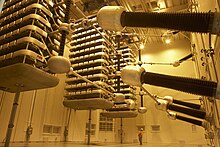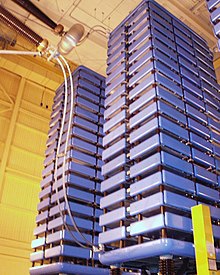Converter station
A converter station is the system in a high-voltage direct current transmission (HVDC), in which the conversion of three-phase current into direct current (and vice versa) takes place. Thus, as required, three-phase current can be made from direct current and direct current from three-phase current. A converter station always includes the converter as well
- a three-phase switchgear ,
- Converter transformers ,
- Harmonic filter and
- a DC switchgear.

species
A distinction is made between network- commutated English Line Commutated Converter (LCC) and self- commutating English Voltage Source Converter (VSC). Line-commutated converters are able to transmit power of more than 7 GW at an operating voltage of 800 kV, but require reactive power from the three-phase network. Self-commutated systems within the scope of the Flexible AC Transmission System (FACTS) are able to provide or absorb inductive or capacitive reactive power and can also serve to control the power flow in the AC voltage network.
Components
Converter hall
The converter hall, also valve hall (Engl. Valve hall ), is the building in which the power converter, typically thyristors , formerly also mercury arc rectifiers are housed. Mercury vapor rectifiers were placed on insulators in the converter hall, while thyristors were either placed on insulators or hung from the ceiling. The latter requires a more stable ceiling construction, but it can withstand earthquakes better than a standing structure. Often several valve functions are combined in one thyristor tower. In addition to the converter hall, there is often an additional building in which the control electronics, devices for cooling and monitoring, devices for the power supply of the auxiliary devices and social rooms are housed.
Since the converters carry a high electrical voltage to earth during operation, the converter hall must not be entered while the system is in operation. As a rule, a window is therefore provided in the ancillary building from which the control is carried out so that you can take a look at the system. Since numerous high-voltage direct current transmission systems are controlled remotely, remote monitoring devices are also often installed.
In some high-voltage direct current transmission systems, such as the HVDC Cahora Bassa , power converters were used, which are set up in the open air in oil-filled containers. There is no converter hall for such systems, which are exceptional.
DC switchgear
The direct current switchgear almost always has a smoothing choke for smoothing the direct current. Their inductance is between 0.1 H and 1 H. The smoothing choke can be designed as an air- core coil or as a coil with an iron core. In the latter case, it looks similar to a high-voltage transformer and, like such a transformer, is usually cooled with oil. Smoothing chokes designed as air-core coils are mostly similar in design to carrier frequency blocking coils in high-voltage lines, but have significantly larger dimensions. Like these, they are mostly mounted on insulators. Air chokes have the advantage of generating less noise than iron chokes.
The direct current switchgear always includes direct current and direct voltage transducers. For this purpose, transducers in series and parallel to the DC output are used.
Occasionally, direct current filters are also used to remove high-frequency interference signals. Such filters are necessary in particular when messages are to be transmitted on the direct current line using the carrier frequency method in the range between 30 kHz and 500 kHz or when the direct current line is designed as an overhead line that passes in the immediate vicinity of residential buildings. These can consist of LC elements and thus be passive, or consist of an amplifier coupled by a transformer and protective capacitors and thus be active. Such an amplifier sends a signal to the line that is 180 degrees out of phase with the interference signal, thereby eliminating the interference. Such a system is used in the HVDC Baltic Cable .
Power converter

Power converters have been designed using thyristor technology since the mid-1970s, with 12-pulse three-phase rectifiers almost always being used in order to reduce the complexity of the harmonic filter . In older systems, mercury vapor rectifiers are occasionally still in use. While with these each rectifier is set up individually, with thyristor converters 4 converter valves are combined into one module, the thyristor tower . 3 thyristor towers are therefore required for a complete converter.
IGBTs are mostly used instead of thyristors in systems that are not operated with an intermediate circuit but with a voltage intermediate circuit . In these systems, the structure of the power converter differs fundamentally from that with thyristors.
Converter transformers
The converter transformers are not only used to adapt the voltage of the three-phase network to that of the HVDC, but also through the special circuit (star-star-delta circuit) to eliminate numerous harmonics if the converter is designed in 12-pulse circuit and is only operated in this circuit. Since the turns of the converter transformers carry a direct voltage potential to earth, the insulation of the turns of these transformers must be specially dimensioned. Converter transformers can be implemented as a complete unit for outputs of up to approx. 300 MVA. For reasons of transport technology, several units are possible for larger outputs. Either two three-phase units (with 2 windings) or three single-phase units (with 3 windings) can be used here. The latter variant has the advantage that only one type of transformer is required, which makes the provision of a replacement transformer more economical.
Since power converter transformers carry a high level of harmonic content, they generate more noise than comparable transformers in normal substations, which must be taken into account when installing them. A converter transformer that is in operation generates a much louder noise than a normal three-phase transformer. Converter transformers are set up in the immediate vicinity of the converter. In some modern systems, these are housed in extensions to the converter hall, which also results in better noise protection .
Harmonic filter
In systems with six-pulse operation, odd harmonics occur from the 5th order. Harmonic filters are used to eliminate them . For pure reactive power generation , capacitor banks or chokes are connected in parallel to the harmonic filter.
Other filters
With 12-pulse converter systems, one or two bandpass filters tuned to the 12th and 24th harmonics are often sufficient, since only harmonics of the order 12 × n + 1 and 12 × n - 1 (n = natural number) occur. In addition, matched series resonance circuits can also be used.
In addition to the harmonic filters, there are often filters for eliminating interference signals in the frequency range of PLC systems (30 kHz to 500 kHz). These filters are usually located in the immediate vicinity of the three-phase output of the converter transformer. They consist of a coil through which the load current flows and to which a capacitor is connected in parallel. Synchronous phase shifters are also used.
Three-phase switchgear
The actual three-phase switchgear of a converter station does not differ in principle from that of a normal substation. It can have transformer fields for other voltage levels.
Converter stations for HVDC close couplings
Converter stations for HVDC close couplings do not differ in principle from those for long-distance transmissions. However, in such systems the converter hall usually contains both converters. Since the length of the direct current line is very short, no complex direct current filters are necessary.
Others
Space requirement
The area required for a converter station with 600 megawatts of transmission capacity and a transmission voltage of 400 kV is around 300 × 300 meters.
Location factors
Since converter stations can emit noise and high-frequency interference signals, such a system should not necessarily be located near residential areas. If necessary, it must be surrounded by a noise barrier . As with normal substations, care must be taken to ensure that no oil from transformers or other components can get into the groundwater in the event of an accident.
Converter stations in Germany
- GKK Etzenricht (HVDC short coupling, 160 kV, 600 MW, commissioned in 1993, shut down since 1995)
- Converter station Lübeck - Herrenwyk of the HVDC Baltic Cable (450 kV, 600 MW, start of operation 1994)
- Converter station Bentwisch of HVDC Kontek (400 kV, 600 MW, start of operation 1996)
- Offshore HVDC systems are systems for high-voltage direct current transmission of offshore wind power on land. So far, they have only been used in Germany, as offshore wind farms, in contrast to Great Britain and Denmark, are being built at a greater distance from the coast (the HVDC BorWin1 to Diele is already in operation , others are under construction).
Former converter stations in Austria
- GK Dürnrohr (HVDC short coupling, 145 kV, 550 MW, commissioned in 1983, shut down since 1996)
- GK Wien-Südost (HVDC short coupling, 160 kV, 600 MW, commissioned in 1993, decommissioned since 1996)
literature
- H. Wayne Beaty, Donald G. Fink: Standard Handbook for Electrical Engineers . 15th edition. McGraw-Hill, 2006, ISBN 978-0-07-144146-9 (Chapter 15).
Web links
Individual evidence
- ↑ Sandra Ullrich, Transmission Networks , in: Martin Wietschel, Sandra Ullrich, Peter Markewitz, Friedrich Schulte, Fabio Genoese (eds.), Energy Technologies of the Future. Generation, storage, efficiency and networks , Wiesbaden 2015, pp. 267–322, pp. 299f.

